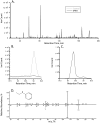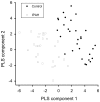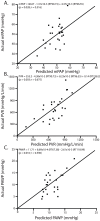Analysis of volatile compounds in exhaled breath condensate in patients with severe pulmonary arterial hypertension
- PMID: 24748102
- PMCID: PMC3991617
- DOI: 10.1371/journal.pone.0095331
Analysis of volatile compounds in exhaled breath condensate in patients with severe pulmonary arterial hypertension
Abstract
Background: An important challenge to pulmonary arterial hypertension (PAH) diagnosis and treatment is early detection of occult pulmonary vascular pathology. Symptoms are frequently confused with other disease entities that lead to inappropriate interventions and allow for progression to advanced states of disease. There is a significant need to develop new markers for early disease detection and management of PAH.
Methodolgy and findings: Exhaled breath condensate (EBC) samples were compared from 30 age-matched normal healthy individuals and 27 New York Heart Association functional class III and IV idiopathic pulmonary arterial hypertenion (IPAH) patients, a subgroup of PAH. Volatile organic compounds (VOC) in EBC samples were analyzed using gas chromatography/mass spectrometry (GC/MS). Individual peaks in GC profiles were identified in both groups and correlated with pulmonary hemodynamic and clinical endpoints in the IPAH group. Additionally, GC/MS data were analyzed using autoregression followed by partial least squares regression (AR/PLSR) analysis to discriminate between the IPAH and control groups. After correcting for medicaitons, there were 62 unique compounds in the control group, 32 unique compounds in the IPAH group, and 14 in-common compounds between groups. Peak-by-peak analysis of GC profiles of IPAH group EBC samples identified 6 compounds significantly correlated with pulmonary hemodynamic variables important in IPAH diagnosis. AR/PLSR analysis of GC/MS data resulted in a distinct and identifiable metabolic signature for IPAH patients.
Conclusions: These findings indicate the utility of EBC VOC analysis to discriminate between severe IPAH and a healthy population; additionally, we identified potential novel biomarkers that correlated with IPAH pulmonary hemodynamic variables that may be important in screening for less severe forms IPAH.
Conflict of interest statement
Figures



Similar articles
-
Exhaled volatile organic compounds in individuals with a history of high altitude pulmonary edema and varying hypoxia-induced responses.J Breath Res. 2015 Apr 20;9(2):026004. doi: 10.1088/1752-7155/9/2/026004. J Breath Res. 2015. PMID: 25891856
-
Evidence of endogenous volatile organic compounds as biomarkers of diseases in alveolar breath.Ann Pharm Fr. 2013 Jul;71(4):203-15. doi: 10.1016/j.pharma.2013.05.002. Epub 2013 Jun 17. Ann Pharm Fr. 2013. PMID: 23835018 Review.
-
Exhaled breath condensate: determination of non-volatile compounds and their potential for clinical diagnosis and monitoring. A review.Anal Chim Acta. 2013 Dec 17;805:1-18. doi: 10.1016/j.aca.2013.07.049. Epub 2013 Jul 31. Anal Chim Acta. 2013. PMID: 24296139 Review.
-
Development of a method for metabolomic analysis of human exhaled breath condensate by gas chromatography-mass spectrometry in high resolution mode.Anal Chim Acta. 2015 Aug 5;887:118-126. doi: 10.1016/j.aca.2015.07.008. Epub 2015 Aug 8. Anal Chim Acta. 2015. PMID: 26320793
-
Exhaled breath condensate in pulmonary arterial hypertension.J Breath Res. 2012 Sep;6(3):036006. doi: 10.1088/1752-7155/6/3/036006. Epub 2012 Aug 2. J Breath Res. 2012. PMID: 22854169
Cited by
-
'There and Back Again'-Forward Genetics and Reverse Phenotyping in Pulmonary Arterial Hypertension.Genes (Basel). 2020 Nov 26;11(12):1408. doi: 10.3390/genes11121408. Genes (Basel). 2020. PMID: 33256119 Free PMC article. Review.
-
Volatolomics in healthcare and its advanced detection technology.Nano Res. 2022;15(9):8185-8213. doi: 10.1007/s12274-022-4459-3. Epub 2022 Jun 29. Nano Res. 2022. PMID: 35789633 Free PMC article. Review.
-
Hypertension in rats is associated with an increased permeability of the colon to TMA, a gut bacteria metabolite.PLoS One. 2017 Dec 13;12(12):e0189310. doi: 10.1371/journal.pone.0189310. eCollection 2017. PLoS One. 2017. PMID: 29236735 Free PMC article.
-
The role of volatile organic compounds for assessing characteristics and severity of non-cystic fibrosis bronchiectasis: an observational study.Front Med (Lausanne). 2024 Apr 3;11:1345165. doi: 10.3389/fmed.2024.1345165. eCollection 2024. Front Med (Lausanne). 2024. PMID: 38633315 Free PMC article.
-
Pulmonary hypertension and chronic lung disease: where are we headed?Eur Respir Rev. 2019 Oct 21;28(153):190065. doi: 10.1183/16000617.0065-2019. Print 2019 Sep 30. Eur Respir Rev. 2019. PMID: 31636088 Free PMC article. Review.
References
-
- Alfaro MF, Walby WF, Adams WC, Schelegle ES (2007) Breath condensate levels of 8-isoprostane and leukotriene B4 after ozone inhalation are greater in sensitive versus nonsensitive subjects. Exp Lung Res 33: 115–133. - PubMed
-
- Carpagnano GE, Resta O, Gelardi M, Spanevello A, Di Gioia G, et al. (2007) Exhaled inflammatory markers in aspirin-induced asthma syndrome. Am J Rhinology 21(5): 542–547. - PubMed
-
- Phillips M, Altorki N, Austin J, Cameron RB, Cataneo RN, et al. (2007) Prediction of lung cancer using volatile biomarkers in breath. Cancer Biomarkers 3(2): 95–109. - PubMed
Publication types
MeSH terms
Substances
LinkOut - more resources
Full Text Sources
Other Literature Sources
Medical
Molecular Biology Databases
Research Materials
Miscellaneous

